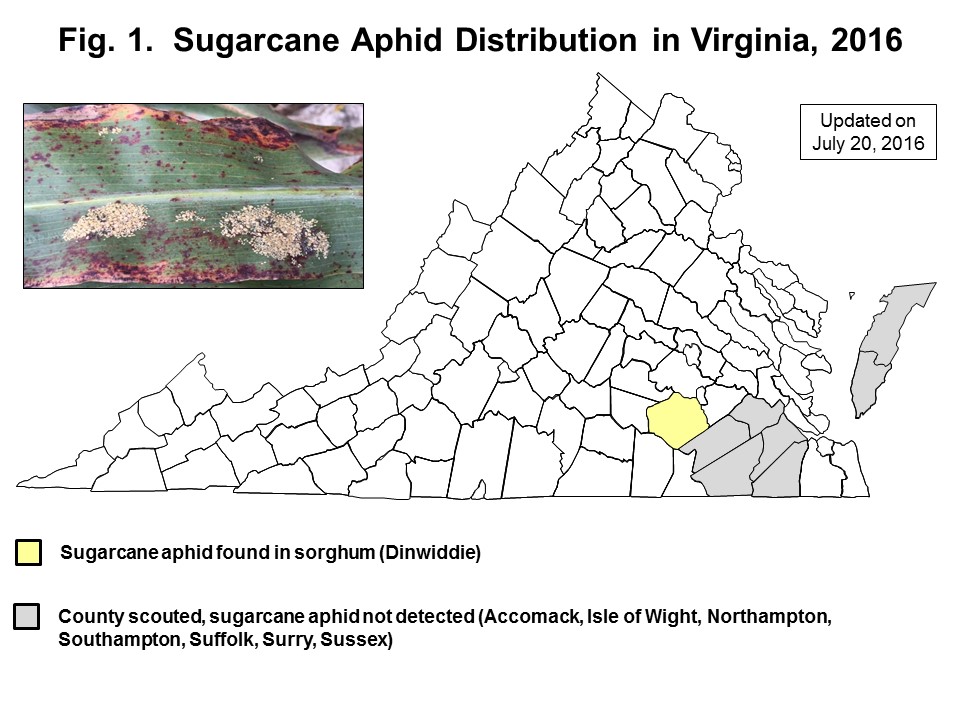On July 20, 2016, Virginia Cooperative Extension Agent Mike Parrish submitted an insect sample collected from sorghum in Dinwiddie County, VA, that we confirmed as sugarcane aphid (Melanaphis sacchari). Last year, this aphid was not found in Virginia until late September (in Isle of Wight, Prince George, Southampton, Suffolk, Surry, and Sussex Counties). Infestations can stunt or even kill sorghum plants that are in the pre-head stage, and after heading the honeydew can interfere with mechanical harvest by plugging up combines.
Researchers at the Virginia Tech Tidewater and Southern Piedmont Agricultural Research and Extension Centers (Dr. Maria Balota’s crew, including Dr. Joseph Oakes; the Entomology crew; and Dr. Chris Teutsch) have been scouting sorghum for several weeks now—please see Figure 1 for our current findings.
With sugarcane aphids’ ability to spread and reproduce rapidly, sorghum scouting should begin immediately and be conducted at least weekly. Start with sorghum field edges, especially checking the underside of lower leaves. Leaves that are shiny with honeydew are a clue that aphids are present on that plant. Once aphids are found, scouting should be conducted at shorter intervals to actively monitor population growth. The economic thresholds for treatment of sugarcane aphid are provided in Table 1 and are based on North Carolina Cooperative Extension recommendations.
Table 1. Economic thresholds for treatment of sugarcane aphid in sorghum.
| Growth Stage | Threshold |
| Pre-boot | 20% infested plants with localized area of honeydew and established aphid colonies |
| Boot | 20% infested plants with localized area of honeydew and established aphid colonies |
| Flowering-milk | 30% infested plants with localized area of honeydew and established aphid colonies |
| Soft dough | 30% infested plants with localized area of honeydew and established aphid colonies |
| Dough | 30% infested plants with localized area of honeydew and established aphid colonies |
| Black layer | Heavy honeydew and established aphid colonies in head (treat to avoid problems at harvest) |
Thresholds in this table are from Sugarcane Aphid Now Present in NC-2016 https://entomology.ces.ncsu.edu/2016/07/sugarcane-aphid-now-present-in-nc-2016/ by Dr. Dominic Reisig, Associate Professor and Extension Specialist, NCSU.
In Virginia, two insecticides are recommended for sugarcane aphid control in sorghum, Sivanto (which has a FIFRA Section 2(ee) Recommendation for a reduced rate, including Virginia), and Transform WG (which is registered under a Section 18 emergency exemption for Virginia) (Table 2). Repeat applications should rotate chemistries. Good coverage of the plant with insecticides is essential for effective control. A minimum spray volume of 10 gpa is recommended. Please be sure to carefully read and follow the label.
IMPORTANT NOTE: Insecticides with pyrethroid as the active ingredient are NOT recommended for the control of sugarcane aphid. The efficacy of pyrethroid insecticides against the sugarcane aphid is low and they negatively impact the population of natural predators. This often results in a rapid increase in sugarcane aphid populations immediately following application.
Table 2. Insecticides recommended for the control of sugarcane aphid in sorghum.
| Insecticide | Active Ingredient | Application Rate | Max Annual Application Rate | Pre-Harvest Interval |
| oz/A | oz/A/year | days | ||
| Sivanto | flupyradifurone | 4-7 | 28 | 7 (forage) AND 21 (grain) |
| Transform WG | sulfoxaflor | 0.75-1.5 | 3.0 | 7 (forage) AND 14 (grain) |
For more information on the sugarcane aphid, please contact your local extension agent. Contact information can be found at http://www.ext.vt.edu/offices/index.html.

